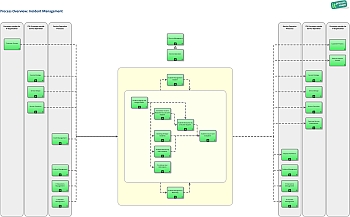Incident Management
| diese Seite auf Deutsch |
|---|
ITIL Version: ITIL Version 3 (ITIL V3)
Part of: Service Operation
Process Objective: To manage the lifecycle of all Incidents. The primary objective of Incident Management is to return the IT service to users as quickly as possible.
Process Owner: Incident Manager
ITIL V3 vs. ITIL V2: Incident Management
- Essentially, the activities and process objectives of the Incident Management process are identical in ITIL V2 and V3
- ITIL V3 distinguishes between Incidents (Service Interruptions) and Service Requests (standard requests from users, e.g. password resets)
- Service Requests are no longer fulfilled by Incident Management; instead there is a new process called Request Fulfilment
- There is a dedicated process now for dealing with emergencies ("Major Incidents")
- A process interface was added between Event Management and Incident Management. Significant Events are now triggering the creation of an Incident
Sub-Processes of Incident Management (ITIL V3)

- Incident Management Support
- Process Objective: To provide and maintain the tools, processes, skills and rules for an effective and efficient handling of Incidents.
- Incident Logging and Categorization
- Process Objective: To record and prioritize the Incident with appropriate deligence, in order to facilitate a swift and effective resolution.
- Immediate Incident Resolution by 1st Level Support
- Process Objective: An Incident (service interruption) is to be solved within the agreed timeschedule. The aim is the fast recovery of the IT service, where necessary with the aid of a Workaround. As soon as it becomes clear that 1st Level Support is not able to resolve the Incident itself or when target times for 1st level resolution are exceeded, the Incident is transferred to a suitable group within 2nd Level Support.
- Incident Resolution by 2nd Level Support
- Process Objective: An Incident (service interruption) is to be solved within the agreed timeschedule. The aim is the fast recovery of the service, where necessary by means of a Workaround. If required, specialist support groups or third-party suppliers (3rd Level Support) are involved. If the correction of the root cause is not possible, a Problem Record is created and the error-correction transferred to Problem Management.
- Handling of Major Incidents
- Process Objective: A major Incident is to be solved. Major Incidents cause serious interruptons of business activities and must be solved with greater urgency. The aim is the fast recovery of the service, where necessary by means of a workaround. If required, specialist support groups or third-party suppliers (3rd Level Support) are involved. If the correction of the root cause is not possible, a Problem Record is created and the error-correction transfered to Problem Management.
- Incident Closure and Evaluation
- Process Objective: To submit the Incident Record to a final quality control before it is closed. The aim is to make sure that the Incident is actually resolved and that all information required to describe the Incident's life-cycle is supplied in sufficient detail. In addition to this, findings from the resolution of the Incident are to be recorded for future use.
- Incident Monitoring and Escalation
- Process Objective: The processing status of outstanding Incidents is to be continuously monitored, so that counter-measures may be introduced as soon as possible if service levels are likely to be breached.
- Pro-Active User Information
- Process Objective: To inform users of service failures as soon as these are known to the Service Desk, so that users are in a position to adjust themselves to interruptions. Proactive user information also aims to reduce the number of inquiries by users. This process is also responsible for distributing other information to users, e.g. security alerts.
- Incident Management Reporting
- Process Objective: To supply Incident-related information to the other Service Management processes, and to ensure that that improvement potentials are derived from past Incidents.
Related Key Performance Indicators






